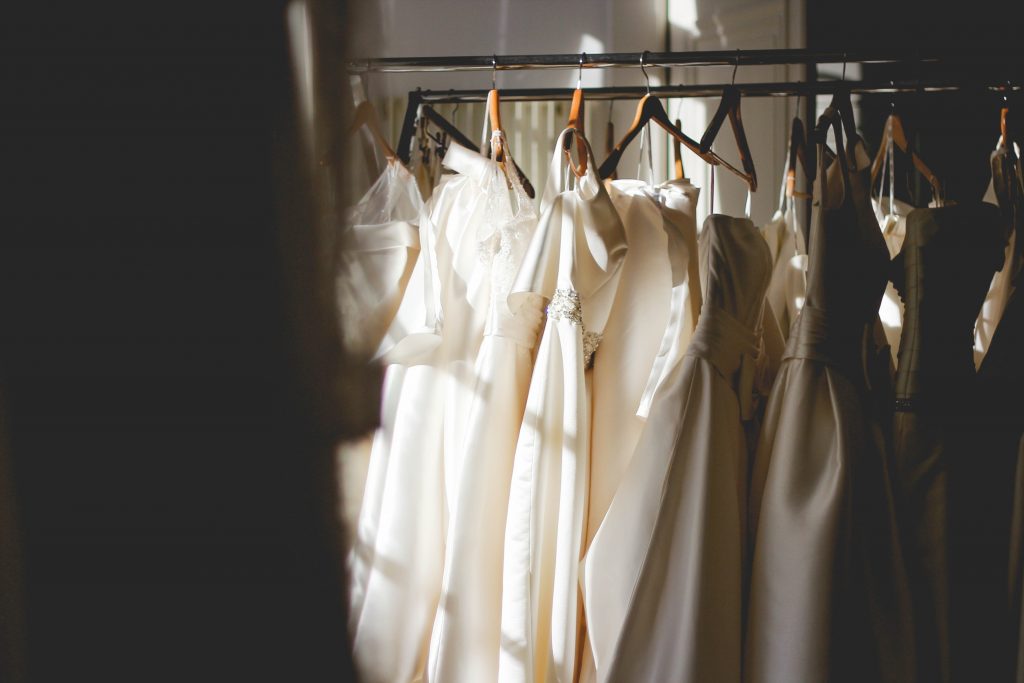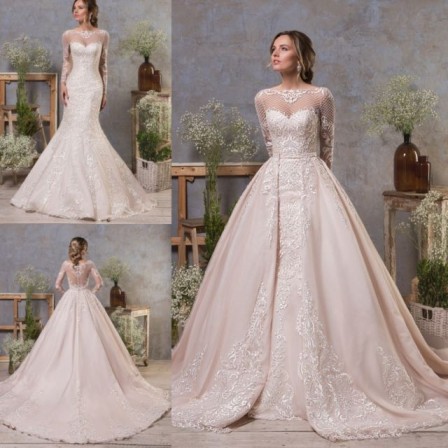First things first: the best wedding dress for your body type is the style that makes you feel like celebrating, whether you’re a bit more trim, muscular or curvy. That being said, wedding dress shopping is a different experience than picking up a new sundress from your favorite store. Wedding dresses are structured and tailored to fit your unique shape. They often incorporate elements we don’t see in everyday modern wear such as boning, intricate lace, petticoats and bustles.
Even if you’ve already locked into your favorite wedding dress type for your body, it’s worth considering all your options, as a unique wedding dress style may surprise you. It is often not until you slip on a new dress style do you see how it hides or showcases certain areas of your frame.
Wedding dress styles generally come in several main shapes:
- Sheath
- Trumpet and Mermaid
- A-Line
- Dropped Waist
- Empire Waist
- Ball gown
Each varies by skirt length and fullness, waistline placement, neckline and structure of the dress. While some dresses provide maximum support with boning, strong bodices and 3-D embellishments, others sit right on the body with minimal accompaniments.
Where to Begin

Before you head to the bridal salon, peruse the “real weddings” section of your favorite wedding sites. Seeing real brides with a range of body type can help you envision how the style may translate to your shape.
Next, prioritize the following questions:
- Which areas of my body do I feel the best about?
- Are there areas of my body that require more support?
- How can I reflect my personal style in the dress?
- Will I be comfortable during a long event?
- What season am I getting married? Do I need to consider the weather?
Select several photos of dress styles and images to show to your dress expert when you arrive at the boutique. They have an in-depth awareness of their inventory that could be difficult to find by just perusing the store on your own. On the other hand, they may also encourage you to head through the racks to see what catches your eye in person.
Sheath or Column Wedding Dresses
Growing in popularity over the past several years, this sleek and modern look creates clean lines and minimal fabric. Depending on the fabric style and cut, the sheath dress blends with both a casual bohemian-style wedding or a black-tie event.
Best for: Those seeking the least structure and fullness in their dress. This shape often fully showcases the shape of the body, so is ideal for those comfortable showing off their figure while maintaining flexibility and comfort. It is particularly popular with trim and athletic builds as it hangs naturally on the body. Its flowing length also elongates the body, ideal for both tall and shorter brides looking to add a bit of height through a heal.
Trouble spots: Sheath and column dresses can be trickier for full-chested women or those looking to draw attention away from specific areas of their body. Due to the thin fabric, it may be harder to find undergarments that do not throw off the line of the dress.
Variations: Necklines of a sheath dress vastly range from a high boat neck to strapless. With less weight to the fabric, there is little need for additional straps or structure to hold the dress in place. The skirt often flows to the floor or features a train, and the waist commonly falls at or just above the natural line.
Trumpet and Mermaid Dresses

Accentuating a body’s hourglass shape, a trumpet or mermaid style dress adds a bit of classic glamour to a wedding day no matter the wedding theme. Though similar, these two dress varieties do differ slightly in the lower skirt’s structure. Trumpet skirts begin to flare around the center of the thigh, creating a more subtle silhouette. Mermaid skirts reflect their namesake, flaring out dramatically just about the knee for a more dramatic shape.
Best for: Brides looking to accentuate wider hips and chest. The dramatic shape showcases and pulls in the waist, wonderfully showing off the broader body structures. Since the material hugs the body, these two dress shapes are also ideal for those comfortable making a bit more of a statement and flaunting their curves. Many mermaid dresses work in significant structure in the bodice, an ideal option for those looking for more support on their wedding day.
Trouble Spots: Tight-fitting mermaid dresses are not always the most dance-friendly gowns, but this completely depends on the fit of the skirt. This shape is also not ideal for those hoping to avoid accentuating their hips and chest, especially if they’re aiming for a more conservative appearance.
Variations: Since the skirt tightens around the legs, comfort and flexibility can be a concern. Trumpet dresses provide a happy medium between an elegant hourglass shape and a bit more flexibility. Instead of clinging to the knees, trumpets create the same shape but drape around the legs. As with each dress variety, the bodice and neckline include all shapes, straps and embellishments.
A-Line Dresses

This iconic look is what often comes to mind when people think of wedding dresses for the first time. The “princess” shape to the skirt reflects the old-fashioned look of a ball gown without quite as much differentiation between the bodice and the skirt. Overall, the dress makes an “A” shape to reflect its name.
Best for: A-Line dresses are versatile for nearly all body types, typically hugging right at the natural waist before flaring out. If you’re looking for a little more freedom in the tummy area and hips, many A-Line dresses allow freedom to show or hide whichever parts of your body you choose. This style is also ideal for those looking to show off a more conservative elegance in a church or outdoor wedding, as many styles work well with sleeves or pashminas.
Trouble Spots: The traditional style of this dress is not right for every personality. If you’re for wedding dress silhouettes with a more unique flair, A-line dresses may not have the variety you’re looking for. More diminutive women may also not enjoy how the bulk of fabric in an A-line dress can swallow up the length of their legs or torso.
Variations: The neckline on an A-line dress offers the greatest versatility, range from strapless to full sleeves. Some designers create dresses that transition from long to short sleeves between the ceremony and reception. Of all the wedding dress styles, these also work best in shorter lengths. The fun A-line shape works as a tea-length dress right below the knee or at the knee for a retro look.
Dropped Waist Wedding Dresses
The dropped waist wedding dress comes in a range of styles, combining its look with other dress structures on this list. On a basic level, the waist like falls below the natural line, either blending naturally into the hip or even falling to the top of the thighs. This does one of two things: it either creates a clean and uninterrupted silhouette – ideas for intricate lace and beading – or creates a variation of the trumpet style with a higher break between the skirt and bodice.
Best for: Since dropped-waist dresses encompass such a wide variety of shapes and dress structures, they cater to all body type, trim and curvy. Dropped waist dresses can also make quite a style statement, especially when the lower part of the skirt flares dramatically at the lowered waistline.
Trouble spots: Those looking to draw attention away from their hips and stomach may not enjoy the hug of the long bodice. This is also an ideal shape for those looking to flaunt natural curves, though doesn’t necessarily adapt to very thin and athletic body types.
Variations: Dropped-waist dresses run the gamut from laid-back and bohemian to dramatic and bold depending on the placement of the waistline itself. For example, while some elaborate lace designs cascade directly from the bodice to the skirt, others cut out to the sides at the more extreme angle, creating an elongated trumpet.
Empire Waist Wedding Dresses
Moving the other direction, empire waists stem back to the late-18th century. The waistline sits just below the chest, far above the natural waistline. This allows the skirt to naturally fall from the torso straight to the floor, creating an elegant and flowing line. Some modern empire waists remain fitted further into the midsection before lightly flaring out. No matter the level of bodice structure, the skirt is allowed to flow naturally from a higher point in the body.
Best for: Those looking to elongate their body line. With the skirt the primary focus on the dress, the skirt moves with ease and allows plenty of comfort as the wedding progresses.
Trouble spots: Without ample support below the higher waistline, those with fuller figures may not be drawn to this flowing skirt shape. This greatly depends on the structure of the dress itself, however.
Variations: Though the empire waist has an iconic look to the line of the dress, both the body and skirt can vary in material, embellishments and fullness. Blend a modern ball gown look with the empire style in a dress that includes a full skirt and petticoat but a higher waistline. A tighter bodice holds up the heavier skirt in these cases.
On the other side of things, empire waist dresses often create a bohemian-style dress. The bodice may have less structure, a high waist and a free-flowing skirt.
Ball Gowns

For those looking to make a grand entrance to their wedding ceremony, the ball gown typically includes a tight, fitted bodice and a very full skirt billowing out from the natural waistline. This “fairy-tale” silhouette mirrors the look of a princess entering a ball. Similar to A-line dresses, the heavier skirt calls for a more structured bodice to support the fabric.
Best for: Brides looking for an elegant, dramatic look who feel most comfortable in structured dresses. The additional boning or support is ideal for those with fuller chests and mid-sections and though looking to accentuate their natural upper-body curves.
Trouble spots: The thickness of the ball gown layers can be constrictive to flow of movement and full-day comfort. The more structure bodice is not best for those who prefer to remain flexible throughout the day or with outdoor, hot-weather events. The large dress and ample fabric can also swallow up petite brides if the skirt is too full.
Variations: Ball gowns vary significantly in the length of their skirt, ranging from floor-length to cathedral-length trains. The natural fullness of the skirt makes it easier to bustle during the reception to allow for greater movement and freedom to dance.
Finding the right wedding gown for your body type always comes down to comfort. Physical comfort – both in where you prefer the dress to hug and where you’d prefer more freedom – is just as important as mental comfort such as the style of your wedding day and how you’d like to feel during your celebration.
You and your boutique assistant can work together to explore which unique design sums up your one-of-a-kind look. In addition to fit and style, consider factors like your wedding day theme, your reception colors and even the style of your wedding venue. When all these factors work in tandem, the perfect dress should make you feel like celebrating from morning to night.

